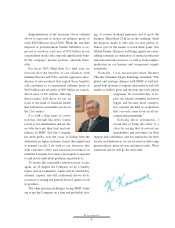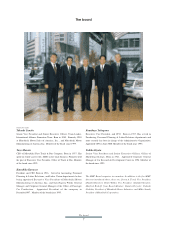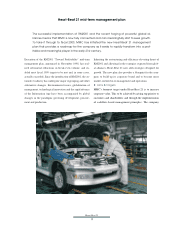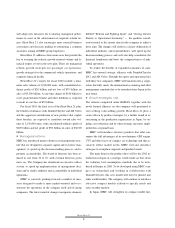Mitsubishi 2000 Annual Report Download - page 18
Download and view the complete annual report
Please find page 18 of the 2000 Mitsubishi annual report below. You can navigate through the pages in the report by either clicking on the pages listed below, or by using the keyword search tool below to find specific information within the annual report.
commitment required to make them a success. Our joint
assembly operation with Chrysler and the sales channel
that we established ourselves were neither outright suc-
cesses. This is why two years ago we took the decision to
make a concerted investment in the United States, on the
premise that products for the US market would be de-
signed by Americans and designed in and built in
America. We are still shipping a fair number of built-up
RVs from Japan but eventually we shall phase out ex-
ports and switch fully to a local market-oriented opera-
tion. This represents a 180-degree change of direction in
our approach to projects in North America; and that is
what Project America is all about. Coming about while
we were in the process of implementing this change of
direction, the alliance with DaimlerChrysler will realize
important synergies, enabling mutual complementation
and sharing of resources.
H: What specific areas of collaboration are you discussing
with DaimlerChrysler at the moment?
K: MMC and DaimlerChrysler are currently looking at col-
laboration in three main areas: the Z-Car, the Asian mar-
ket and the North American market. If something else
should come of this collaboration, that's fine. The board
members at DaimlerChrysler are open-minded and ready
to consider any constructive proposition.
The last four or five years have seen major changes in
the environment the Japanese manufacturing industry op-
erates in, and a wide range of responses to those changes
has been available. It is, however, my personal opinion
that today the only viable paths to survival are: the one
chosen by Nissan or that which we have embarked upon.
We have to operate today in a world that many presidents
and top management from the old school of the Japanese
manufacturing industry find difficult to come to grips
with. It requires a 180-degree change in their way of
thinking. Making the appropriate response requires a full
understanding of the changes that have occurred, some-
thing the old school of management will find difficult
(laughter). But, the bottom line is that that's the age we
now live in.
H: You have recently created the position of chief financial
officer. Was this a measure designed to keep the al-
liances running smoothly?
K: Industry observers talk about the convoluted nature of
our commercial vehicle and passenger car alliances. I
have never thought that ensuring their success will be a
simple matter. In fact, the real test is still to come. One
way of making our commercial vehicle and passenger car
operations self-supporting was to first spin off the com-
mercial vehicle division as an independent company. But
then we are confronted with the major problem of decid-
ing on their relative importance for capital investment
purposes, and how best to allocate capital fairly. I see
this, and have thought so right from the beginning, as be-
ing a task of vital importance; one that is my responsibil-
ity to achieve.
Decisions on the allocation of capital between com-
mercial vehicle and passenger car operations should be
made by a corporate department that is capable of look-
On the analyst's couch: 2000
16
Stephen Usher
























